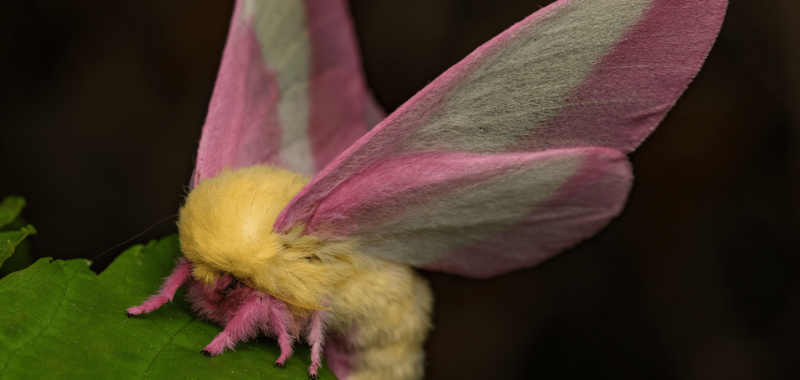The planet’s over 160,000 moth species are best known for their nighttime flights and being power pollinators. Now, some moths are opening an evolutionary window into how one species can diverge into separate species with different traits. The so-called disco gene might be behind a stark difference in flight patterns in two colorful moths. The findings are described in a study published August 27 in the journal Proceedings of the Royal Society B: Biological Sciences and details how this gene may help regulate day or night flight.
When species diverge
In nature, one species can diverge and become two or more over time. This process called speciation occurs when individuals from a single population become geographically isolated. The finches of the Galápagos that Charles Darwin studied are among the most famous examples of speciation. About 13 finch species have diverged from a single ancestor when their populations were spread across several islands and evolved separately. If the populations of organisms remain separate long enough, they eventually will lose the ability to interbreed.
For some moths, their genetics have been impacted by the time of day that they are most active and not by separation due to a physical barrier like an ocean or mountain range. In this new study, the team focused on two closely related moth species that have overlapping ranges in the southeastern United States.
[Related: Moths fight against echolocating bats with sounds of their own.]
Rosy maple moths are in the genus Dryocampa. They sport a thick, fluffy mane above their head and abdomen, with candy colored pink and yellow scales. Male and female rosy moths only fly during the night.
Pink-striped oakworm moths are slightly less flashy and members of the genus Anisota. They have more earthy tones of mustard yellow, dark brown, and gray. Female pink-striped oakworm moths are active during dusk and early evening hours, while males prefer to fly during the day.
“These two [species] are very similar,” study co-author and Florida Museum of Natural History entomologist Yash Sondhi said in a statement. “They’ve differentiated along this one axis, which is when they fly.”
Earlier studies found that both Dryocampa and Anisota originated from one species roughly 3.8 million years ago. By evolution’s standards, this is fairly recent and there are still some key differences and similarities among them. A handful of species in the genus Anisota are all active during the day, unlike the modern female pink-striped oakworm moths who prefer dusk and nighttime flying. The nocturnal rosy maple moths are also the only known species in the genus Dryocampa.

Originally, Sondhi believed that both types of moth would be a good opportunity to explore how insect vision evolves and when a species changes its pattern of activity. However, that was not in the cards.
“I went in looking for differences in color vision. Instead, we found differences in their clock genes, which in hindsight makes sense,” Sondhi said.
Genes that ‘tell time’
Clock genes are specialized genes that control circadian rhythm in both animals and plants. The changes in the proteins that clock genes create makes cells either active or dormant over a period of roughly 24 hours. They can also impact more than just sleep and awake cycles. Clock genes can affect an organism’s cell growth, blood pressure, body temperature, and metabolism and are found across a wide range of organisms.
“It’s a system that’s been retained in everything from fruit flies to mammals and plants,” Sondhi said. “They all have some kind of time-keeping mechanism.”
[Related: The science behind our circadian rhythms, and why time changes mess them up.]
After finding these differences in their clock genes, Sondhi compared the transcriptomes of the two moth species. Transcriptomes contain only one subset of genetic material and determine when and where a gene is turned on or off in an organism’s cells and tissues. By comparison, genomes contain all of an animal’s DNA. This makes transcriptomes helpful when exploring differences in an organism’s protein levels throughout the day since they have more specific information on these proteins.
Sondhi found a number of genes that were expressed in different quantities in both moth species. The nocturnal rosy maple moths invested more energy in their sense of smell, while the day-flying oakworm moth produced more genes that are associated with vision.
The disco gene and its ‘zinc fingers’
One additional gene stood out during this analysis–disco. Short for disconnected, disco was expressed at different levels during the daytime and nighttime hours in both species. Previous research in fruit flies found that disco can indirectly influence circadian rhythms via the production of the neurons that send clock enzymes from the brain to the body.
The disco gene that was found in the moth samples was roughly twice the size of its counterpart in the fruit fly. It also had additional zinc fingers. These are active portions of a gene that directly interact with proteins, DNA, and RNA. Sondhi believed that the changes in the disco gene were at least partially responsible for the rosy maple moth’s shift to night-flying.
[Related: Why artificial light—and evolution—trap moths.]
When he compared the disco gene of rosy maple moths with the disco gene in oakworms, Sondhi found 23 mutations that separated the two. These mutations were also located in active portions of the gene, so they could also potentially contribute to some of the visible physical differences between the moths.
Additional study could also help scientists understand the ways that genes change in the wild and how speciation works on the molecular level.

